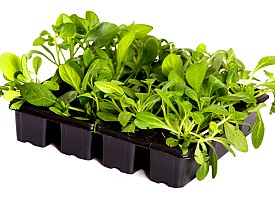It's February, Which Means Start Some Seeds!
 Unless you live in the Southern hemisphere or very close to the equator, it is now February for you, with all of the cliches in full effect. Number one, it is cold. This is the month when people actually start thinking about calling that roofing contractor to insulate the old attic because the plan to go back to nature and keep the temperature in the house at 50 degrees Fahrenheit is failing. You want that consistent 72 degrees, and you want it now.
Unless you live in the Southern hemisphere or very close to the equator, it is now February for you, with all of the cliches in full effect. Number one, it is cold. This is the month when people actually start thinking about calling that roofing contractor to insulate the old attic because the plan to go back to nature and keep the temperature in the house at 50 degrees Fahrenheit is failing. You want that consistent 72 degrees, and you want it now.
Also, in February you have the Super Bowl. The Super Bowl, if you didn't know, is a Sunday that necessitates driving to Costco to buy frozen meatballs, packaged guacamole, cases of Bud, and bags of potato chips the size of elephant heads. February is clearly not a month when most people in the Northern Hemisphere are thinking about gardening. Mostly we have hunkered down with bags of leftover, off-price Valentine's Day candy in front of the TV, or frantically calling our plumber in Chicago or whatever frozen locale we live in because the pipes are frozen. We like it that way, so keep your stupid gardening to yourself. Article is over. Buh bye.
Just kidding! We're going to talk about gardening, because late February and early March are the times to start seeds. First of all, I am writing in a very general way about then exactly you should start your seeds, because it varies by plant and by zone. Someone who is gardening in South Carolina will be able to get plants into the ground before someone who lives in Maine. However, even if you live somewhere that is freakin' freezing, February is still the right time to start preparing for spring planting.
Here are the supplies that you will need to amass during the month of February: Seeds (duh), planting medium (potting soil), plastic trays to plant in, fun little sundries like paper towels, plastic wrap, plant markers, and possibly fertilizers and anti-mold materials (we'll get to it).
Not every plant needs to be started so very early in the season. It will say on the seed packet how many weeks the seed needs to started in advance of the transplant date. You'll be transplanting the seed after the last frost. Take a look at a hardiness zone chart, or talk to local gardeners, to find out the approximate date of the last frost.
To learn the process of germinating and transplanting seeds, I recommend reading a publication by your local cooperative extension service, like this article published by the University of Maine Cooperative Extension. Just to give you an overview of what you will be doing: Start by hydrating your seeds. Some people skip this step; others swear by it. Next, you'll germinate the seeds. Place seeds in a sunny place on damp paper towels. Mist the seeds to keep them moist for several days, until their little "tails" poke out from the seed's shell. Next, you'll plant the germinated seed in soil. Don't plant it in clay pots; you'll need to start your seeds in shallow plastic containers. Used yogurt containers with holes poked in their bottoms, or plastic seed pot trays, are the best containers for starting seeds. Place clean potting soil into the plastic containers, and then submerge the germinated seed in the soil. Cover the seed with soil tightly (pack it down) and moisten the soil. At this point, you have the option of sprinkling some activated charcoal or chicken grit on top of the soil to prevent "damping off." Cover the containers tightly with plastic wrap secured by rubber bands. Place in the sun or under a grow light. Do not water until the seed has sprouted. At that point, you can remove the plastic cover and water only when the soil is dry to the touch. When the time comes, you'll transplant the baby plants to larger pots and place them outside. Most gardeners in cooler climates acclimatize the plants to cooler outdoor temperatures by exposing them to the outdoors for several hours a day for a few days before permanently transplanting them to outdoor beds or containers.
Talk to me. Tell me about your failures and successes starting plants during the winter in the comments!
Looking for a Pro? Call us (866) 441-6648

Landscaping Average Costs
Landscapers Experiences

Oak Tree Planting Looks Great In Our New Home’s Spacious Yard

Yard Clean Up Left Our Lawn Looking Fantastic



